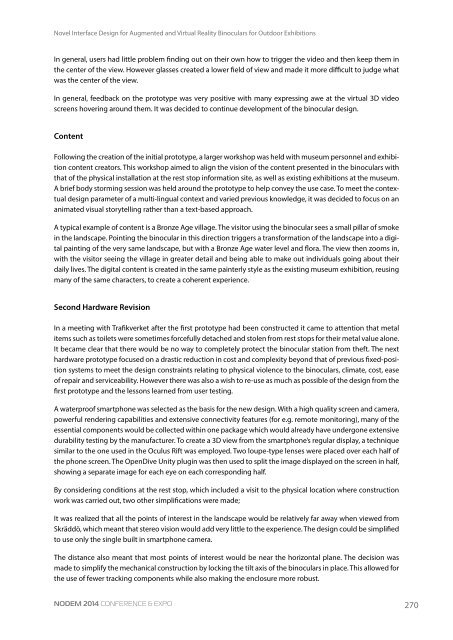NODEM 2014 Proceedings
NODEM 2014 Proceedings
NODEM 2014 Proceedings
You also want an ePaper? Increase the reach of your titles
YUMPU automatically turns print PDFs into web optimized ePapers that Google loves.
Novel Interface Design for Augmented and Virtual Reality Binoculars for Outdoor Exhibitions<br />
In general, users had little problem finding out on their own how to trigger the video and then keep them in<br />
the center of the view. However glasses created a lower field of view and made it more difficult to judge what<br />
was the center of the view.<br />
In general, feedback on the prototype was very positive with many expressing awe at the virtual 3D video<br />
screens hovering around them. It was decided to continue development of the binocular design.<br />
Content<br />
Following the creation of the initial prototype, a larger workshop was held with museum personnel and exhibition<br />
content creators. This workshop aimed to align the vision of the content presented in the binoculars with<br />
that of the physical installation at the rest stop information site, as well as existing exhibitions at the museum.<br />
A brief body storming session was held around the prototype to help convey the use case. To meet the contextual<br />
design parameter of a multi-lingual context and varied previous knowledge, it was decided to focus on an<br />
animated visual storytelling rather than a text-based approach.<br />
A typical example of content is a Bronze Age village. The visitor using the binocular sees a small pillar of smoke<br />
in the landscape. Pointing the binocular in this direction triggers a transformation of the landscape into a digital<br />
painting of the very same landscape, but with a Bronze Age water level and flora. The view then zooms in,<br />
with the visitor seeing the village in greater detail and being able to make out individuals going about their<br />
daily lives. The digital content is created in the same painterly style as the existing museum exhibition, reusing<br />
many of the same characters, to create a coherent experience.<br />
Second Hardware Revision<br />
In a meeting with Trafikverket after the first prototype had been constructed it came to attention that metal<br />
items such as toilets were sometimes forcefully detached and stolen from rest stops for their metal value alone.<br />
It became clear that there would be no way to completely protect the binocular station from theft. The next<br />
hardware prototype focused on a drastic reduction in cost and complexity beyond that of previous fixed-position<br />
systems to meet the design constraints relating to physical violence to the binoculars, climate, cost, ease<br />
of repair and serviceability. However there was also a wish to re-use as much as possible of the design from the<br />
first prototype and the lessons learned from user testing.<br />
A waterproof smartphone was selected as the basis for the new design. With a high quality screen and camera,<br />
powerful rendering capabilities and extensive connectivity features (for e.g. remote monitoring), many of the<br />
essential components would be collected within one package which would already have undergone extensive<br />
durability testing by the manufacturer. To create a 3D view from the smartphone’s regular display, a technique<br />
similar to the one used in the Oculus Rift was employed. Two loupe-type lenses were placed over each half of<br />
the phone screen. The OpenDive Unity plugin was then used to split the image displayed on the screen in half,<br />
showing a separate image for each eye on each corresponding half.<br />
By considering conditions at the rest stop, which included a visit to the physical location where construction<br />
work was carried out, two other simplifications were made;<br />
It was realized that all the points of interest in the landscape would be relatively far away when viewed from<br />
Skräddö, which meant that stereo vision would add very little to the experience. The design could be simplified<br />
to use only the single built in smartphone camera.<br />
The distance also meant that most points of interest would be near the horizontal plane. The decision was<br />
made to simplify the mechanical construction by locking the tilt axis of the binoculars in place. This allowed for<br />
the use of fewer tracking components while also making the enclosure more robust.<br />
<strong>NODEM</strong> <strong>2014</strong> Conference & Expo<br />
270


